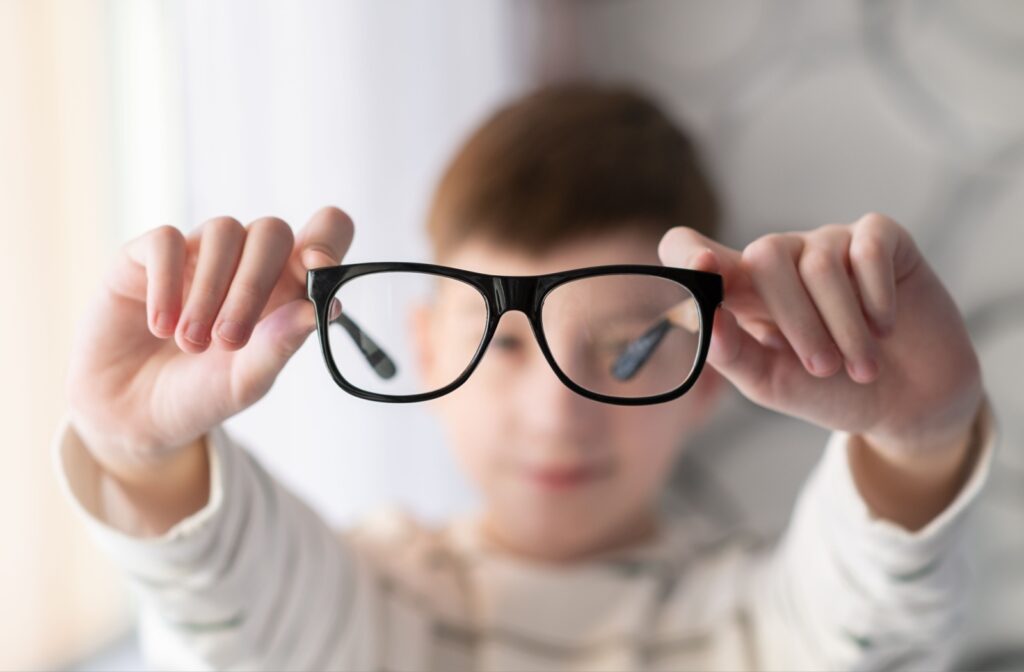Blurry vision is a common vision problem that many of us experience. There could be several underlying causes of blurry vision, including astigmatism, myopia, and hyperopia.
Astigmatism causes blurred vision at all distances, myopia is blurry distant vision, and hyperopia is blurry near vision. Regular eye exams can detect and correct these refractive errors to provide visual clarity and comfort.
What Is a Refractive Error?
Myopia, hyperopia, and astigmatism are refractive errors, meaning these eye conditions affect how your eyes focus light. Refractive errors do not relate to eye diseases but rather the shape of the eye, cornea (clear front part of the eye), or lens (inner part of the eye that helps with focus).
A refractive error is a vision problem caused by the eye incorrectly focusing light onto the retina (the light-sensitive tissue at the back of the eye). In a normal-shaped eye, when light enters, it bends or refracts onto the retina to form a clear image.
However, in a refractive error, due to an abnormally-shaped eye, the light refracts in front of the retina, behind the retina, or unevenly as it enters the eye. The most common refractive errors are myopia (nearsightedness), hyperopia (farsightedness), and astigmatism.
What Is Astigmatism?
Astigmatism is when the cornea or lens has a different shape than normal, leading to blurry or distorted vision at all distances. Essentially, the irregular curvature of the cornea or lens causes the eye to have more than one focal point when it enters the eye. The irregularity in shape can be intrinsic to the eye or a result of external factors, including eye injury or eye surgery.
Symptoms of astigmatism include:
- Blurry or distorted vision
- Eye strain
- Headaches
- Squinting
- Difficulty seeing at night
You may not notice symptoms of mild astigmatism. A comprehensive eye exam with tests that measure how the eyes focus light and how much light enters the eyes can diagnose astigmatism.
Astigmatism is commonly corrected with glasses or contact lenses specifically designed to compensate for the eye’s irregular shape. Surgical options like laser eye surgery can restore the cornea to a more regular shape for a more permanent solution.
What Is Myopia?
Myopia is a condition that affects millions worldwide. It causes objects at a distance to become unclear, but ones up close are clear. Myopia occurs when the eyeball is too long relative to the focusing power of the cornea and lens. When light enters the eyes, it focuses in front of the retina instead of directly on it.
Symptoms of myopia typically become noticeable in childhood and worsen as the eye grows. Children may present with the following myopia symptoms:
- Blurry distant vision
- Struggle to see the board at school
- Squinting
- Eye strain
Children are often unaware they may have a refractive error as they don’t know what clear, comfortable vision is. Myopia can also progress and increase a child’s risk of sight-threatening eye diseases later in life.
Corrective lenses, whether glasses or contact lenses, can help bring distant objects into focus. Early detection with eye exams and myopia control methods are also necessary to prevent myopia progression in young children.
What Is Hyperopia?
Hyperopia is the opposite of myopia, affecting clear vision on close objects, but distance viewing is largely unaffected. When a person is farsighted, light focuses behind the retina either because the eyeball is too short or the cornea has too little curvature. Hyperopia leads to blurry near vision and clear distant vision.
Farsightedness can often go undetected in mild hyperopia. However, with time, the impact on the eyes becomes evident, leading to symptoms like:
- Headaches
- Eye fatigue
- Eye strain
- Sore eyes
Hyperopia diagnosis is the same as with other refractive errors— comprehensive eye exams. Similar to myopia, glasses or contact lenses can correct hyperopia. Refractive surgery is also an option for those looking to diminish or do away with reliance on corrective lenses.

The Key Differences in Astigmatism, Myopia, & Hyperopia
While each of these conditions affects how light focuses in the eye, they have distinct differences:
- Myopia: A longer-than-normal eye or steeply curved cornea causes light to focus in front of the retina, leading to blurry distant vision.
- Hyperopia: A shorter-than-normal eye or a flatter-than-usual cornea causes light to focus behind the retina, leading to blurry near vision.
- Astigmatism: Irregular curvature of the cornea or lens leads to multiple focal points and distorted vision at all distances.
The Focus on Eye Exams
We can’t overstate the importance of regular eye exams for detecting refractive errors early and to prevent them from progressing or increasing your risk of more severe eye conditions. By understanding the differences between astigmatism, myopia, and hyperopia, you can become more aware of changes to your vision and seek appropriate recommendations from your eye doctor.
Stay proactive and book an appointment with Restore Vision Center to address vision concerns and maintain your vision clarity.



